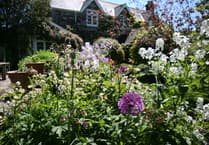AN appeal has come from the other side of the world to farmers here in West Devon for information on an unusual agricultural implement — a left hand sheep shearing machine.
Australian Des de Belle is asking for Times readers who have any brochure, instruction manual or parts list related to the machine to contact him.
Des, who is 81, and lives in Canberra, said: 'I am an Australian who was fortunate enough to have spent several years in Europe and the UK in the 1950s and 60s.
'The Times of June 5, 1964, had a news item "Shearing Sheep the Aussie Way" — I am the Desmond de Belle of that article, who had that shearing team in the South and West until 1968, when I returned to Australia.
'I had been given a left hand machine while in England but it has disappeared in the years since.
'There are a group of collectors of sheep shearing memorabilia here in Australia, of whom I am one, who have often talked of left hand machines.
'I doubt they were ever used in Australia, because of the size of flocks and the number of shearers in the big shearing sheds that had all machines, running off a long line shaft mostly driven by large traction engines.
'Needless to say, I was often told I was dreaming or just telling stories, but I do know that R A Lister of Dursley and the Wolseley sheep shearing machine company did make machines and marked them "left hand".'
Des himself comes from a long line of sheep farmers — born in Bathurst, New South Wales, both sides of his family had connections with sheep and farming.
'My mother's family — family name Press — originated from Wiveliscombe in Somerset and arrived in Australia in November, 1849.
'They settled in the Bathurst area and soon after had property. The first on my father's side, arrived in 1836 from Madras, India as a convict,' said Des.
'My father's parents had died many years before I came along, his father having passed away in 1900 leaving a family of two boys and eight girls, the youngest being only five years old.'
Des's father was in the Australian Army during the first world war. He served in France and was wounded late in 1918. From his service records, Des learnt he was at Sutton Veny in Wiltshire, convalescing before returning to Australia in 1919 on a British freighter, the City of Exeter.
'During the years between the two world wars,' said Des, 'he was a shearer for many years, and I can recall he was often away from home and working in some of the big sheep properties of that time.
'With a family history like that, and spending school holidays on grandparents' and uncles' farms, is it any wonder that I learnt to shear!
'When I decided to go shearing, my father told me two things —never think you will be the best shearer in any shed. No maatter how good a shearer you become, there will always be someone who is better than you.
'Always do the right thing, and you can always go back. Step out of line once and that is the only thing you will be remembered for!'
Des said thanks to shearing, he had been fortunate enough to travel the world. For more than 30 years he sheared sheep in Australia, New Zealand, England, France, the USA and Canada.
Des added: 'Shearing in England came up in a round-about way. While in New Zealand in 1956, I met Jim Lawson from Shaftesbury in Dorset.
'Several years later in 1961, I was again in Europe and made my way to London.
'I contacted Jim who advised he had just started his shearing and would I like some work.
'That led to three seasons with Jim, shearing in Hampshire, Wiltshire, Dorset and Somerset.
'That last year, 1963, included my first visit to Lundy, which led to the article in the Times and four shearing seasons in the South and West, before returning to Australia.
'Since that time I have still kept an interest in the wool game, having giving shearing demonstrations and talks on the history of sheep and wool in this country for many years.'
Des would especially like to hear from people who have any information about left hand sheep shearing machines. Email him at [email protected]">[email protected]


.jpeg?width=209&height=140&crop=209:145,smart&quality=75)
-with-lightning).jpeg?width=209&height=140&crop=209:145,smart&quality=75)
Comments
This article has no comments yet. Be the first to leave a comment.